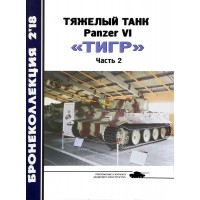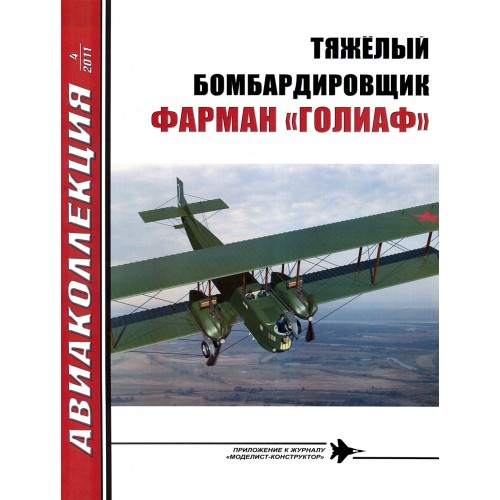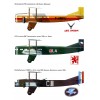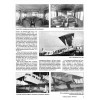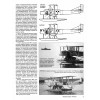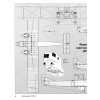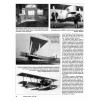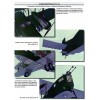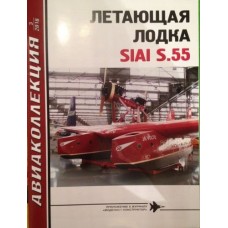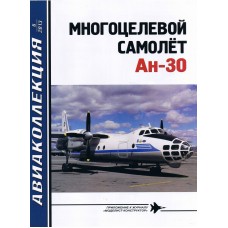AKL-201104 AviaCollection / AviaKollektsia series 4/2011: Farman Goliath French Heavy Biplane Bomber Aircraft. Photos, schemes, colour pictures. 32 pages, soft cover, text in Russian.
CREATING A PLANE
In 1918, Société de Avions Henri et Maurice Farman designed the twin-engine FF.60 bomber (FF stands for Freres Farman for the Farman brothers). The work was supervised by engineer Fichet. According to the French classification, the aircraft belonged to the BN2 category - a two-seater night bomber. The aircraft was supposed to carry a very large maximum payload at that time - 1500 - 2000 kg, including 1000 kg of bombs. According to calculations, the speed should have been 150 km / h, the bomber was supposed to climb 2000 m in 15 min 52 s, and the practical ceiling should reach 5800 m. The flight range of 1500 km was calculated from the conditions of hitting targets in the depths of Germany, such as like Berlin or Essen.
It was a large (with a wingspan of 28 m) biplane, built almost entirely of wood. Previously, the designers considered options for both a biplane and a monoplane. Anri Farman insisted on the layout of the biplane, citing a smaller wingspan, which allows the bomber to be hidden in a much smaller hangar.
The span of the upper and lower wings was the same, as was their design - two wooden spars, wooden ribs and sheathing of plywood and canvas. This plane was the first in the world to use box spars. The wing set was reinforced with cross braces. The wings are rectangular in plan, with large ailerons with horn compensation. Ailerons, connected to each other, stood on both the upper and lower wings.
Initially, the designers intended to use two new 18-cylinder Salmson 18Z engines with a capacity of 500 hp each. But they never got out of the experimental stage. I had to focus on what was available. We chose other engines of the same company, Salmson CM9, also star-shaped water-cooled, but single-row 9-cylinder, 260 hp each. This decision was to seriously affect the flight data of the machine. I had to go to reduce the takeoff weight by reducing the payload to 1000 kg. The engines were placed in gondolas on the lower wing. There were also oil and gasoline tanks. The water coolers were in front of the engines, the toe of the crankshaft running through them. Exhaust manifolds were used as radiator frames. Like most airplanes of that time,
The fuselage of rectangular cross-section had a wooden frame sheathed with plywood. In the corners were massive spar beams. The transverse set of struts and frames was reinforced with cross braces. It was planned to place bomb racks under the center section between the landing gear struts. The landing gear legs with characteristic linen fairings in the form of "pants" were reinforced with a set of braces. Each strut had rubber plate shock absorbers and carried twin wheels. The tail support was a wooden crutch.
Although the FF.60 was smaller in size than the Russian "Ilya Muromets" or the English Handley-Page 0/400, it looked quite impressive, for which it received the name "Goliath". The military approved the project and were preparing to issue large orders for the new car. Serial production was planned for 1919. The Farman Brothers Factory began building two prototypes of the bomber. But they did not have time to complete the work on them. In November 1918, the First World War ended, orders still outstanding were canceled.
The question arose - what to do with the FF.60? The military decided to use the vehicles to transport the commanding staff of the army and navy, as well as officials of the relevant ministries. Both unfinished copies were planned to be converted into passenger cars. A new fuselage was hastily designed. The bow and middle parts were completely redesigned. To create space for passengers, the height of the fuselage was increased. Initially, the aircraft was designed for eight seats with all seats located along the left side. This number was later increased to a dozen. In front of the fuselage, a "viewing salon" with four seats was placed. He took the place of the previous navigator's cockpit with a machine-gun mount on top. The view was provided by an almost continuous strip of windows, under which there were narrow sashes for ventilation. Further there was a platform with a ladder up to the open cockpit.
There, on the left side, sat the pilot, on the right - the flight mechanic, who sometimes could replace the pilot. They were protected from the oncoming stream by a wind visor. Eight seats were mounted in the passenger compartment. They stood along the sides, leaving a narrow passage in the middle. Passengers were able to look through numerous windows made on both sides. These windows could open. In the rear of the cabin, on the right, there was a rectangular entrance door, on the left, a small partition for a toilet (this luxury appeared on the plane for the first time in the world). Next was the trunk. At that time, the new plane looked very comfortable.
In this form, the first "Goliath" was shown to the public in January 1919 and took off in the same month. Since the car was converted from a bomber, transverse cross braces remained in the fuselage, preventing movement in the rear compartment. From the cockpit, which was not fenced off from the cabins, it blew into the seats for passengers. I had to put two partitions with openings for the passage, but without doors. Apparently, no other significant defects were found.
On February 8, the crew of the chief pilot of the Farman company, Lieutenant Lucien Bossutro, and the mechanic Muelot with ten passengers flew from the French town of Toussoux-le-Noble to Kenly near London. The British did not allow civilian aircraft to fly over their territory, so the Goliath bore a full set of military designations, and the crew and passengers were military personnel (these included four officers and six soldiers). On the same day, the plane returned to France.
Even before the start of mass production, it was decided to launch the Goliaths on regular airlines. By that time, Farman had already organized its own airline, Lines Farman. The second copy of the aircraft was successfully completed by that time. On February 12, he started from Paris to Brussels. Bossutro piloted again, with him the mechanic Hera flew. Historians write that in total there were 24 people on board: Henri Farman and his wife, Eugene Serre - commercial director of Lines Farman and a group of French and Belgian journalists. How they were placed with 12 seats is not clear! The flight pursued the goal of preparing one of the two planned lines of the Farmanovskoy airline. We flew in fog and with low clouds, but reached the Belgian capital safely.
In the spring of 1919, Bossutro set three records one after another. On April 1, with four passengers, he ascended the Goliath to an altitude of 6200 m, spending 1 hour 05 minutes. On April 3, the plane climbed to the same altitude, but with 14 passengers, and on May 5, it climbed 5,000 m with 25 people on board.
They also decided to use the first sample of "Goliath" to demonstrate the capabilities of the new aircraft, but in a different way. On it they were going to make a flight somewhere far away. Bossutro chose Dakar in Senegal. Then it was a French colony, and in general the entire route had to run over the overseas possessions of France.
Additional gas tanks were installed on the car, increasing the range to 2500 km. Assembled a radio station; she stood in the front left in the second saloon. The current was supplied by a generator with a windmill. They loaded up a large amount of supplies in case of an emergency landing - food, medicine, spare parts, including one propeller. They also took weapons, since both wild animals and tribes that did not obey any authorities could meet on earth.
Eight people were to be on board: two pilots (Bossutro and Coupe), two mechanics (Jusset and Muelot), three officers and a brother of the co-pilot, also a pilot. On August 11, 1919, the Goliath headed for Casablanca. Having flown 1872 km without landing, he landed safely, spending 18 hours 23 minutes.
On August 14, the plane was in Mogador, and the next day it took off for Dakar. Having flown over the Atlas Mountains, the pilot descended lower to walk under the clouds and see the ground. Suddenly, a leak in the radiator of the right motor came to light. One of the mechanics tied a rope and climbed onto the wing to fix the problem. But his attempt was in vain, the engine overheated. In the middle of the night, the toe of the right engine shaft broke off. The pilot added revs to the remaining engine, but the biplane began to lose altitude; The Goliath was unable to fly with one engine.
AKL-201104 AviaKollektsia N4 2011: Farman 'Goliath' French Heavy Bomber Aircraft (by Vladimir Kotelnikov) magazine
- Brand: AviaCollection / AviaKollektsia
- Product Code: AKL-201104 In Stock
-
$3.90
Available Options
Look at these products too:
AKL-201803 AviaCollection 2018/3 SIAI S.55 Italian Flying Boat of 1920s Story
AKL-201803 AviaCollection / AviaKollektsia series 03/2018: SIAI S.55 Italian Flying Boat of 1920s St..
$3.90





